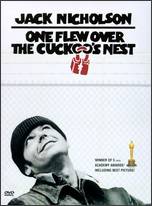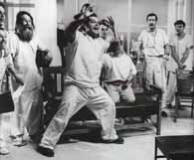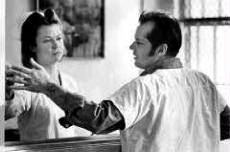FILM NOTES
FILM NOTES INDEX
NYS WRITERS INSTITUTE
HOME PAGE

 One Flew Over the Cuckoo's Nest
One Flew Over the Cuckoo's Nest
(American, 1975, 133 minutes, color, 35mm)
Directed by Milos Forman
Cast:
Jack Nicholson . . . . . . . . . . Randle Patrick McMurphy
Louise Fletcher . . . . . . . . . . Nurse Mildred Ratched
William Redfield . . . . . . . . . . Harding
Dean R. Brooks . . . . . . . . . . Dr. John Spivey
Scatman Crotehrs . . . . . . . . . . Turkle Crothers
Mental illness. It’s been seen on the American screen in a variety of guises. At least as far back as the first decade of the century DREAMS OF A RAREBIT FIEND had presented an image of insanity via the vivid hallucinations—spinning beds, animals dancing in the air—of a man who had eaten too rich a meal. In 1948, THE SNAKE PIT, an earnest social problem film, made a plea for enlightened care. THE THREE FACES OF EVE (1957), a marvelously prurient melodrama, smirked about sex and multiple personality disorder. A fistful of film noirs—SOMEWHERE IN THE NIGHT, THE DARK PAST, NIGHTMARE, THE DARK MIRROR, many others—diagnosed amnesia, schizophrenia, and paranoia in their troubled heroes as a set of complexes that, in milder but still insistent forms, afflicted postwar America in general. 1977s I NEVER PROMISED YOU A ROSE GARDEN finally showed that the American cinema was capable of extending compassion to the mentally ill. In all these cases, however, the mentally ill were a lesser cadre of human, to be scorned, laughed at, or even pitied, but finally, never to be thought of as fellow souls. Only Val Lewton’s disturbing B horror film, BEDLAM (1946), had wondered whether it was, in fact, the society which was sick, and the inmates healthy. The most notorious film about mental illness brought an end to a long period of cinematic self-satisfaction about mental illness. PSYCHO, Alfred Hitchcock’s cruel masterpiece, featured a horrifically unhinged criminal mind, played with engaging sympathy by Anthony Perkins, and a pat but strangely uncomforting explanation of his illness by a psychiatrist brought on in the last act.
PSYCHO’s smug shrink was one of the last in a long line of helpful therapists the movies used to bring the psychologically afflicted back to ‘the real world.’ For Hitchcock, of course, the real world was often as deranged as the most fantastic delusions of the insane. As the 1960s wore on, it became more and more difficult to believe unquestioningly in reintegration to a world which itself seemed mad. There was The Bomb, of course, and the colossal absurdity of Vietnam, a war whose deadly and fanciful narrative could only really be understood by a crazy person.
 Ken Kesey’s novel One Flew Over the Cuckoo’s Nest was published on the cusp of a decade of insanity, and it advanced a novel theory: that the sane were really the insane. Driven berserk by too much violence and regimentation in the world, the doctors, nurses and attendants of Kesey’s mental ward had internalized this militarism of the soul, and had allowed themselves to be transformed into instruments of social control. For Kesey, the mental hospital was a version of modern America, reduced to a portrait in white. And in it, there struggled the psychological refuse of a society, which so fetishized organization that the last true individualists were regarded as nut cases. The novel was a hit among the emerging counterculture, who regarded its hero, the anarchic Randle P. McMurphy, as a standard bearer for a new disloyalty to groupthink. But the book also sold terrifically among the organization men and women themselves, Kesey’s much-reviled worker bees, who by their purchase of One Flew Over the Cuckoo’s Nest, who by their purchase demonstrated that all was not well in the land of General Motors and General Westmoreland.
Ken Kesey’s novel One Flew Over the Cuckoo’s Nest was published on the cusp of a decade of insanity, and it advanced a novel theory: that the sane were really the insane. Driven berserk by too much violence and regimentation in the world, the doctors, nurses and attendants of Kesey’s mental ward had internalized this militarism of the soul, and had allowed themselves to be transformed into instruments of social control. For Kesey, the mental hospital was a version of modern America, reduced to a portrait in white. And in it, there struggled the psychological refuse of a society, which so fetishized organization that the last true individualists were regarded as nut cases. The novel was a hit among the emerging counterculture, who regarded its hero, the anarchic Randle P. McMurphy, as a standard bearer for a new disloyalty to groupthink. But the book also sold terrifically among the organization men and women themselves, Kesey’s much-reviled worker bees, who by their purchase of One Flew Over the Cuckoo’s Nest, who by their purchase demonstrated that all was not well in the land of General Motors and General Westmoreland.
Kirk Douglas saw in McMurphy a part tailor-made for his muscular, howling, messianic screen personality, then being honed in his personal productions such as THE PATHS OF GLORY, SPARTACUS, and LONELY ARE THE BRAVE. He came East to star in Dale Wasserman’s play based on the book in 1963. The play closed after only eleven weeks, but Douglas retained the rights to the material, and struggled for a decade to make the film. By 1974, though, he had to admit that he was too old to play the vital and goofy McMurphy, and he offered the project to his son, sometime-actor Michael. With hard-boiled Saul Zaentz of Fantasy Records, the younger Douglas co-produced the film for release by United Artists on a three-million dollar budget.
It was Michael Douglas’ inspired choice to offer directing duties on the film to Milos Forman. Forman had been one of the leading lights of the Czech cinema during its brief flowering before the Soviet crackdown. Brilliant, cynical, and poetic, Forman’s ability to communicate his fundamentally ironic view of the world to a mass audience made his vision of the mental ward as a nightmare version of America plausible. Somehow, in the wake of Chicago, My Lai, Watergate, and the general Nixonian fin-de-siecle of the early 1970s, Forman found not only absurdity in Kesey’s mental ward, but hope. In ONE FLEW OVER THE CUCKOO’S NEST, Forman turns a sardonic, analytical Eastern European gaze on America. And in Jack Nicholson’s Randle P. McMurphy, he finds a noisy crusader for the restoration of humanity and delight. The progress of McMurphy’s raucous individualism in the film is a profound serious journey, even though it is taken through a series of practical jokes, pratfalls, and gotchas directed at the deep-frozen visage of "Nurse Ratched" (Louise Fletcher). When he is first brought to the ward, McMurphy’s world is a small one, bounded by his own ego. By the time he confronts the death of his capacity to revolt, his has become the voice for all the mute souls of the ward. In a triumphant gesture, he delivers to them the power to articulate their own revolt. His silence gives them speech.
—Kevin Hagopian, Penn State University
….Forman, coming from Czechoslovakia and having seen more than he would like to of institutional tyranny, is coming at "Cuckoo’s Nest" from a cultural angle that entitles him to a more dialectical view of society.
 "Why shouldn’t insane people seem more appealing," he said in answer to my question, "Aren’t we more interesting and more appealing than our government officials? Everybody who involves himself with oppressive machinery is paying for it with a loss of humor, with grayness.
"Why shouldn’t insane people seem more appealing," he said in answer to my question, "Aren’t we more interesting and more appealing than our government officials? Everybody who involves himself with oppressive machinery is paying for it with a loss of humor, with grayness.
"And don’t forget," he added, "this is a ward of only moderately crazy people. The hopeless ones are upstairs." (They are enacted by real patients, and we see them whenever one of the characters goes up for shock treatment.)
"Sometimes we forget," Forman continued, "what a change has taken place in our view of mental illness. Institutions used to be created to protect the community from Evil! This one was built in 1883, at which time it was five miles from the nearest house. Today it’s in the middle of the city. We have to live with the insane, so we had better accept them as human beings."
I asked him about his decision, implemented in the screenplay of Lawrence Hauben and Bo Goldman, to treat the story objectively rather than through the eyes of the Indian, Kesey’s point-of-view character.
"I didn’t want that for my movie," he said. "I hate that voice-over, I hate that whole psychedelic ‘60s drug free-association thing, going with the camera through somebody’s head. That’s fine in the book, or on a stage, which is stylized. But in film the sky is real, the grass is real, the tree is real; the people had better be real too."
"You know, I’m glad I didn’t know the reputation of the book when I read it, so I didn’t have this artificial reverence for the ‘cult classic.’ And I think it’s much better that it was made now than in the ‘60s. After a certain time, all the distracting elements fall away, all the transitory psychedelic stuff. And we can follow what it is really about. My film is very simple."
—Molly Haskell, The Village Voice, December 1, 1975
NOTE: Author Ken Kesey will read from and discuss his work on Tuesday, May 1st (2001) at 8:00 p.m. in Page Hall, 135 Western Avenue on the University at Albany’s downtown campus. Earlier that afternoon at 4:00 p.m. in the Recital Hall, Performing Arts Center on the University’s uptown campus, Kesey will hold an informal seminar.
For additional information, contact the Writers Institute at 518-442-5620 or online at https://www.albany.edu/writers-inst.